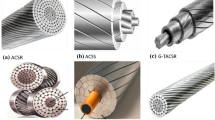Abstract
In the present scenario, demand of electricity is increasing drastically across the country in order to revolutionize development in industrial, agriculture and commercial section. As a consequence, the amount of power transfer capacity has to be enhanced on overhead transmission lines. However, the existing lines are gaining their utmost critical limits of ampacity and sag. This complication has become very predominant to obtain reliable, secure and economic operation of power system. In India, ACSR conductors are generally used in overhead transmission lines for transmission of power. The higher power transferability in existing lines, reduction in losses and optimization of Right of Way of electrical network are the requirement of the today’s power system network. New generation high-performance conductors would help in electric power delivery system for efficient transmission of energy by way of enhancement of power flow per unit of Right of Way and reduction in losses under normal as well as under critical conditions can help in resolving the issues like growing congestion in existing corridors of transmission/distribution network and Right of Way problems. Low-resistant conductor—AL59 alloy conductors and high temperature low sag (HTLS) conductors can be used for re-conductoring of existing lines to mitigate the overloading issues. Several HTLS conductors like STACIR, ACSS, ACCC, TACSR, etc., are available in the market. Selection of HTLS conductor is also an important parameter for re-conductoring of any transmission line. This paper discusses the issues of overloading of transmission line and mitigation by re-conductoring through HTLS conductors. A case study is described by re-conductoring of several HTLS and AL59 conductors, and optimum solution is proposed for avoiding overloading of transmission line.
Access this chapter
Tax calculation will be finalised at checkout
Purchases are for personal use only
Similar content being viewed by others
References
Yan Z, Wang Y, Liang L (2017) Analysis on ampacity of overhead transmission lines being operated. J Inf Process Syst 13(5):1358–1371
Reddy BS, Chatterjee D (2016) Performance evaluation of high temperature high current conductors. IEEE Trans Dielectr Electr Insul 23(3):1570–1579
Mateescu E, Marginean D, Florea G, Gal SIA, Matea C (2011) Re-conductoring using HTLS conductors. In: Case study for a 220 kV double circuit transmission LINE in Romania. 2011 IEEE PES 12th international conference on transmission and distribution construction, operation and live-line maintenance (ESMO), Providence, RI, pp 1–7
Kavanagh T, Armstrong O (2010) An evaluation of high temperature low sag conductors for up-rating the 220 kV transmission network in Ireland. In: 45th international universities power engineering conference UPEC2010. Cardiff, pp 1–5
Kenge AV, Dusane SV, Sarkar J (2016) Statistical analysis & comparison of HTLS conductor with conventional ACSR conductor. In: 2016 international conference on electrical, electronics, and optimization techniques (ICEEOT). Chennai, pp 2955–2959
Energy Research and Development Division, EPRI (2008) Demonstration of advanced conductors for overhead transmission lines. Final project report 1007448, July 2008
Central Electricity Authority (2013) Transmission planning criteria. January 2013
Yasaranga HBD, Wijayapala WDAS, Hemapala KTMU (2017) Techno economic analysis of the use of high temperature low sag (HTLS) conductors in the Sri Lanka’s transmission system. Engineer L(01):41–52
Author information
Authors and Affiliations
Corresponding author
Editor information
Editors and Affiliations
Rights and permissions
Copyright information
© 2020 Springer Nature Singapore Pte Ltd.
About this paper
Cite this paper
Kachhadiya, A., Sheth, C., Gupta, V., Darji, K. (2020). Study and Analysis of HTLS Conductors for Increasing the Thermal Loading of 220 kV Transmission Line. In: Mehta, A., Rawat, A., Chauhan, P. (eds) Advances in Electric Power and Energy Infrastructure. Lecture Notes in Electrical Engineering, vol 608. Springer, Singapore. https://doi.org/10.1007/978-981-15-0206-4_20
Download citation
DOI: https://doi.org/10.1007/978-981-15-0206-4_20
Published:
Publisher Name: Springer, Singapore
Print ISBN: 978-981-15-0205-7
Online ISBN: 978-981-15-0206-4
eBook Packages: EngineeringEngineering (R0)




